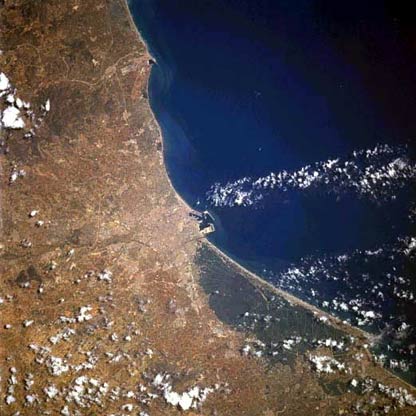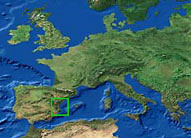 |
 |
 |
|
 |
CupInfo: Valencia, Host City for 2007

Lisbon/Cascais, Portugal
|
Marseilles, France
|
Naples,
Italy
Palma de Mallorca, Spain
|
Valencia,
Spain
View Valencia images from the galleries of
photographer Thierry Martinez.
|
Valencia, Spain The third largest city in Spain, this vibrant Mediterranean destination has over 1,700 restaurants, 42 museums, 13 art galleries, 17 cinemas, 12 theaters, and 30 gardens or municipal parks. The architecture ranges from ancient Roman works to Santiago Calatrava's cutting edge City of Arts and Sciences. Beyond her storied history off the water, Valencia has America’s Cup experience, too. Real Club Náutico de Valencia (founded in 1903) along with the Monte Real Club de Yates, challenged in the 1999 Louis Vuitton Cup on Bravo España. His Majesty King Juan Carlos, the King of Spain, is an avid sailor, racing in prestigious regattas including the recent Queen’s Cup and the Admiral’s Cup. Not that royal interest guaranteed special consideration for Valencia, but the support of the monarch was seen as a significant asset in their bid to host the America's Cup. |
|||
|
|
|
Strengths: |
||
| Sailing Conditions: | Valencia has regular moderate to strong winds owing to a daily sea breeze especially in late spring through October. The warm climate (recorded maximum of 107 degrees F / 42 degrees C) at the coast rising to highlands inshore promotes updraft & resulting wind. Tidal range is moderate with a 1.5 knot current sweeping south along the coast. | |
| Team Infrastructure: | The Balcon al Mar basin has extensive area for the team bases and Cup Village | |
| Support Infrastructure: | Many cultural and social resources for team families and visitors | |
|
General Information: |
||||||
| Population: | 764,000
(Valencia) 40.5 million (Spain) |
|
||||
| Official Language: | Spanish / "Valenciano" | |||||
| Currency: | Euro | |||||
|
Cost comparison:
|
||||||
|
Business Competitive Index: |
Spain Rank: 25th (about the BCI) | |||||
|
Productivity: |
|
GDP per capita, Spain Rank: 22nd |
||||
|
||||
|
Travel Information: |
||||
| Main Airport: | Manises Airport is 8.5 km / 20
minutes north of the city center. Airport code : VLC Transportation services are excellent with flights to & from: Amsterdam, Basle, Brussels, Lisbon, London, Milan, Paris, Zurich (some destinations via Madrid and Barcelona Airports). Iberia, LÍNEAS AÉREAS DE ESPAÑA
http://www.iberia.es |
|||
| Rail Service: | Passenger and freight services are available via the Norte Train Station (Renfe) http://www.renfe.es Travel time: Madrid (3.5 hours), Barcelona (3.5 hours) | |||
| Time Zone: | GMT + 1 hour in winter, GMT +2
in summer (last Sunday in March - last Sunday in September) Dining is delayed versus the much of Europe: breakfast in late continental style, lunch from 13:00 – 15:00, and leisurely dinners from 20:00 – 22:00. Most business is conducted from 10:00 – 13:30 & 16:30 - 20:00 though large concerns may remain open all day. |
|||
| Electricity: | 220-240 V AC, 50 Hz |
|
|
Brief History: |
|||
| Valencia was founded
in 138 BC under the rule of the Romans. The city was later
conquered by the "Visigodos" in 413 and then by the Moors in 714,
who were themselves in turn displaced for years by the Spanish
hero El Cid. In 1238 James I of Aragon's reconquest brought
a degree of self-determination for the Kingdom of Valencia.
By the 15th century under Ferdinand and Isabella, Valencia was
one of the leading economies of the Mediterranean, combining a
strong trade base with a vigorous artistic realm. Today,
she still honors her historic past while pursuing the future with
ultra-modern infrastructure, commerce, and culture. Home to extensive excellent beaches, nestled in a rich garden plateau extending to burnt red highlands, the province of Valencia long ago embraced tourism as an industry. |
|
More information: Official Valencia America's Cup Venue Website Navy Port Guide - Valencia CIA Factbook - Spain Guide to Valencia Travel - Don Quijote Guide to Valencia Travel - Holiday Webcams in Valencia and surroundings
|
| About the photograph from space above: | ||
| Valencia, Spain June 1996 © STS078-732-007 | ||
| Situated on the east coast of the
Iberian Peninsula, Valencia (near center of image) is the capital
of the Valencia Autonomous Region, as well as a major port in
Spain. With an estimated 800,000 people, this historic and
picturesque city is the third largest city in Spain. A modern marine facility that includes a variety of docks and piers that handle even containerized cargo is visible as light-colored structures that jut into the blue waters of the Gulf of Valencia along the eastern edge of the city. The extensive dark area south of the city is a marshy depression that parallels the coast. A lake (very dark area) is barely identifiable near the northern end of the depression. The light colored, linear features are either railroad right of ways or highways. Climatically, this region falls within the Mediterranean climate which features hot summers and cold, damp winters.
Photo Credit: Earth Sciences and
Image Analysis, NASA-Johnson Space Center. 30 Jun. 2003. |
||
|
*Business Competitive Index is a measure of strength and opportunity in the business environment. The BCI is compiled by the World Economic Forum as part of their Global Competitiveness Survey. A simple explanation would mention that it is related to a country's GDP per capita, but, as might be expected where economists are at work, the analysis is much more complicated than simply that one ratio. See their website for more information. |
Inquiries please contact: